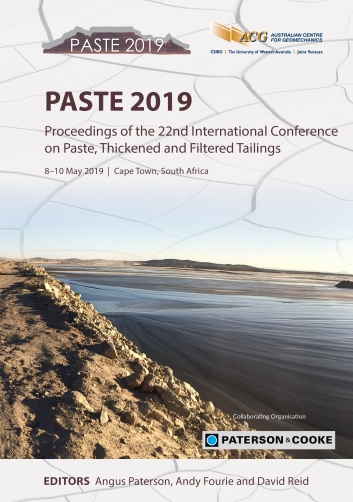Practical tailings slurry dewatering and tailings management strategies for small and medium mines

|
Authors: McPhail, GI; Ugaz, R; Garcia, F |
DOI https://doi.org/10.36487/ACG_rep/1910_15_McPhail
Cite As:
McPhail, GI, Ugaz, R & Garcia, F 2019, 'Practical tailings slurry dewatering and tailings management strategies for small and medium mines', in AJC Paterson, AB Fourie & D Reid (eds), Paste 2019: Proceedings of the 22nd International Conference on Paste, Thickened and Filtered Tailings, Australian Centre for Geomechanics, Perth, pp. 235-243, https://doi.org/10.36487/ACG_rep/1910_15_McPhail
Abstract:
Recent tailings facility failures and the resulting emphasis on ensuring that the best available technology is applied when designing a tailings management system, together with a need to reduce water consumption, have brought about a need for wider evaluation of tailings management approaches. A key determining issue is the extent to which tailings slurry can be cost-effectively dewatered. This issue often drives the selection between high-density slurry, paste and filtered tailings management approaches. Commonly, the focus is purely on thickening, where production rates exceed 30,000 t per day, or filtration, which is most suitable for production rates below 30,000 t per day due to the number of units required, as the means for separating the solids and the liquids. However, there are alternative approaches, suitable for small and medium sized mines, that are not only competitive in terms of capital and operating cost but that may also be significantly more robust and accommodating of variations in ore mineralogy and process plant upsets. These entail the application of hydrocyclones and/or vibratory dewatering screens in conjunction with thickening and/or filtration, sometimes treating only a part of the tailings stream in order to more reliably achieve dewatering targets. The alternative approaches can facilitate more balanced optimisation between the broader drivers of water recovery, slope stability, seepage control and post-closure relinquishment. This paper describes a range of alternative dewatering approaches (in addition to pure thickening or filtration) that merit consideration. It provides insight into the methods of testing and evaluation for selection and sizing of the equipment, describes tailings placement and storage methods associated with varying degrees of dewatering, and discusses the related benefits in terms of robustness of dewatering, water recovery, slope stability, seepage control and post-closure relinquishment.
Keywords: tailings dewatering, solid–liquid separation, high-density slurry
References:
Klug, R, Rivadeneira, A & Schwartz, N 2018, ‘Dewatering tailings: rapid water recovery by means of centrifuges’, Proceedings of the 5th International Seminar on Tailings Management, Gecamin, Santiago.
McPhail, GI 2015, ‘Thickening plant concepts’, in RJ Jewell and AB Fourie (eds), Paste and Thickened Tailings – A Guide, 3rd edn, Australian Centre for Geomechanics, Perth.
Schoepflin, K 2017, ‘Mines in water-scarce areas turn to dewatering screens’, Modern Mining, March, pp. 30–31.
Vakamalla, TR & Mangadoddy, M 2016, ‘Numerical simulation of industrial hydrocyclones performance: role of turbulence modelling’, Separation and Purification Technology, vol. 176, pp. 23–39.
© Copyright 2025, Australian Centre for Geomechanics (ACG), The University of Western Australia. All rights reserved.
View copyright/legal information
Please direct any queries or error reports to repository-acg@uwa.edu.au
View copyright/legal information
Please direct any queries or error reports to repository-acg@uwa.edu.au


